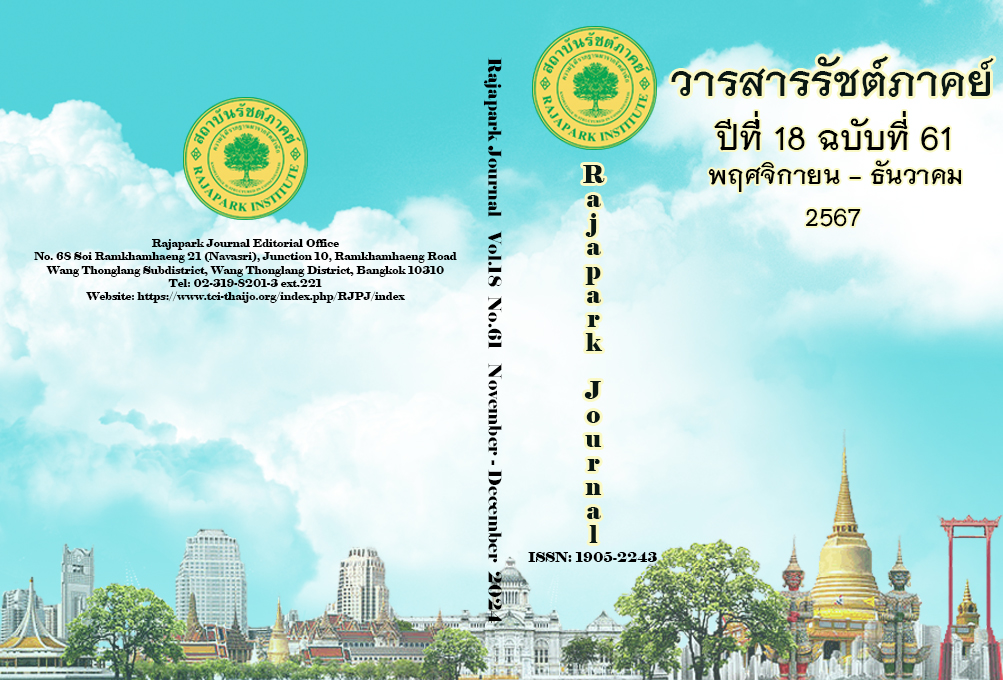Development of Interactive 360 Degree for Enhanced Visitor Experience in Luoyang Museum
Main Article Content
Abstract
This study aimed to 1) develop interactive 360 degrees for enhanced visitor experience in Luoyang Museum; 2) compare visitor perceptions before and after using the interactive 360-degree media in the Luoyang Museum; and 3) evaluate the satisfaction of visitors towards interactive 360 degrees in Luoyang Museum. It was quantitative research. The sample consisted of 400 individuals who provided information before the 360-degree interactions were developed and another 400 who used the interactive media after they were completed. The sample size was determined according to Taro Yamane's formula, and the sample was selected by a simple random sampling method. Data were collected online using the following tools: 1) an evaluation of 360-degree interaction quality; 2) a pre- and post-interaction perception assessment; and 3) a visitor satisfaction evaluation of the 360-degree interaction. Data analysis employed descriptive statistics, including frequency, percentage, mean, standard deviation, and the paired samples t-test.
The research findings revealed that: 1) the development process of the interactive 360-degree exhibit involved three suitable stages, and the interactive media demonstrated high quality; 2) there was a statistically significant difference in visitor perceptions before and after using the interactive 360-degree media at the Luoyang Museum at the 0.05 level; and 3) visitors were highly satisfied with the 360-degree interactive exhibits at the Luoyang Museum. The implementation of interactive technology in museums significantly enhanced the visitor experience and educational outcomes.
Article Details

This work is licensed under a Creative Commons Attribution-NonCommercial-NoDerivatives 4.0 International License.
Views and opinions appearing in the Journal it is the responsibility of the author of the article, and does not constitute the view and responsibility of the editorial team.
References
Argyriou, L., Economou, D., & Bouki, V. (2020). Design methodology for 360° immersive video applications: the case study of a cultural heritage virtual tour. Personal and Ubiquitous Computing, 24, 843-859.
Cinnamon, J., & Jahiu, L. (2023). 360-degree video for virtual place-based research: A review and research agenda. Computers, Environment and Urban Systems, 106, 102044.
Fan, X., Jiang, X., & Deng, N. (2022). Immersive technology: A meta-analysis of augmented/virtual reality applications and their impact on tourism experience. Tourism Management, 91, 104534. https://doi.org/10.1016/j.tourman.2022.104534
Hwang, K., Tom Dieck, M. C., Jung, T., & Kwon, O. (2023). The influence of virtual reality on the experience of religious cultural heritage content. Internet Research, 34(4), 1198-1218. https://doi.org/10.1108/INTR-08-2022-0669
Jia, S., Chi, O. H., Martinez, S. D., & Lu, L. (2023). When ‘Old’ meets ‘New’: Unlocking the future of innovative technology implementation in heritage tourism. Journal of Hospitality & Tourism Research. https://doi.org/10.1177/10963480231205767
Lei, Q. (2017). Luoyang museum new building tour. Heritage World, (8), 4-7.
Li, L., Wensheng, W., & Shan, G. (2019). Luoyang museum new pavilion. Architectural Practice.
Li, Y., & Mohd, K. O. (2024). Investigating the behavioural intentions of museum visitors towards VR: A systematic literature review. Computers in Human Behavior, 155, 108167, https://doi.org/10.1016/j.chb.2024.1
Liao, Y. (2023). Effects of immersive virtual reality technology on online learning outcomes. International Journal of Emerging Technologies in Learning, 18(13). https://doi.org/10.3991/ijet.v18i13.41201
Man, S., & Gao, Z. (2022). Digital immersive interactive experience design of museum cultural heritage based on virtual reality technology. Journal of Electronic Imaging, 32(1). https://doi.org/10.1117/1.JEI.32.1.011208
Pisani, S., Miller, A., & Hall, M. (2023). Digital modes of interpretation of Pictish sculpture. Education and Information Technologies. https://doi.org/10.1007/s10639-023-12151-3
Shin, H.-K. (2023). The virtual museum and acceptance aesthetics of the digital age. Journal of Digital Art Engineering and Multimedia, 10(3), 293-303. https://doi.org/10.29056/jdaem.2023.09.02
Sirikulpipat, P., & Nadprasert, P. (2020). Development virtual museum interactive application with 360-degree and 3D scans virtual reality technology: Case study 10 Museums of Thailand. Journal of Information Science, 38(1), 42-58.
Wu, S. (2022). Research on the application of computer virtual reality technology in museum cultural relics exhibition hall. 2022 IEEE 2nd International Conference on Advanced Electrical Equipment and Control Applications (AEECA). https://doi.org/10.1109/AEECA55500.2022.9919104
Wuebben, D., Rubio-Tamayo, J. L., Barrio, M. G., & Romero-Luis, J. (2023). 360° video for research communication and dissemination: A case study and guidelines. IEEE Transactions on Professional Communication, 66(1), 59-77.
Yamane, T. (1967). Statistics: An introductory analysis (2nd ed.). Harper and Row.
Yang, B. (2023). Virtual reality and augmented reality for immersive learning: A framework of education environment design. International Journal of Emerging Technologies in Learning, 18(20). https://doi.org/10.3991/ijet.v18i20.44209


